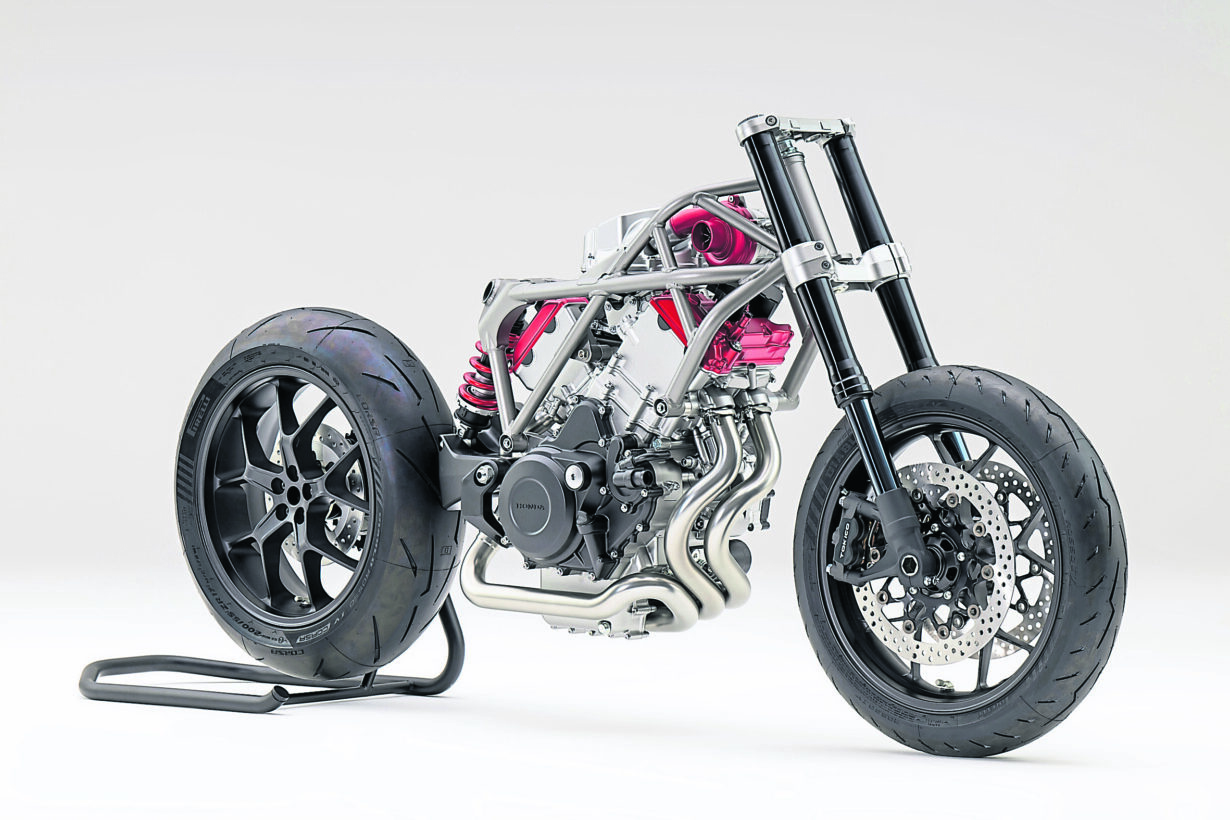Alan Dowds takes a look at how this could help save petrol-powered bikes
Honda’s electrically-supercharged V3 concept was one of the most interesting things shown at EICMA. Our man Dowds looks at how this could help save petrol-powered bikes
Sometimes in life, things aren’t quite what they seem. When Honda unveiled a new 75° V-3 engine at the Milan show, with a radical new electric supercharger set up, everyone rushed to speculate about how much power we’d be getting, what wild superbike it would power, and how it could revolutionise MotoGP and WSBK racing.

But there’s another side to the tech as well – which might be even more useful to the bike world overall. Because an electric supercharger could just help bikes escape the move to pure battery power, at least in the short and medium term, by making small, super-efficient, hybrid powerplants that use much less petrol.
First a bit of a recap on the basic technology. Supercharging – or forced induction – is a great way of improving the performance of a small engine. If you can pump more air into the combustion chamber than would normally be drawn in through the intake ports, you can then add extra fuel, making bigger explosions. That gives more force on top of the piston, increasing engine torque, hence, more power from a smaller capacity. Smaller engines are lighter, more compact, and have lower levels of friction – so when they’re ‘off-boost’ they use less fuel and produce lower emissions. But on full gas, they can give big engine power, so you get the best of both worlds. It’s why most modern internal combustion-engined cars have shrunk in capacity and number of cylinders – three-litre sixes turned into two-litre fours with turbos, and four-litre V-8s became twin-turbo three-litre sixes, all of them cleaner, lighter and more fuel efficient, while still making the big power and torque.
Up until now, forced induction engines have used turbochargers or superchargers. Turbos use the energy in the engine’s exhaust to drive the compressor, while superchargers use a mechanical drive from the engine. Both have pros and cons: turbos need a complex turbine and compressor system exposed to hot exhaust gases, adding cooling and lubrication demands, as well as a large, expensive exhaust turbo manifold which brings packaging issues (they’re generally sticking out where the front wheel has to go). But a turbo uses otherwise-wasted energy from the exhaust gas flow to compress the intake charge. Superchargers are simpler – though they need a direct drive (often a belt) from the engine crankshaft.
This new Honda set up adds another dimension though. Using an electric motor to compress the intake charge is novel technology, only really seen so far on F1 race car engines. There are loads of advantages. With a smart ECU control, the engine designer will be able to dial in whatever intake pressure they fancy, within the limits of the electric motor, at any point in the rev range. So, you won’t be waiting for a heavy turbocharger turbine and compressor wheel to accelerate, or a mechanical supercharger to speed up with the engine revs.

That could obviously bring performance advantages in terms of peak power – but the other advantage is efficiency. Having an electrical supercharger drive means the energy to compress the intake charge will come from a battery pack. That battery can be charged up gradually, as with a hybrid car, taking otherwise-wasted energy when slowing down or braking, and even a little bit while idling or cruising. So, while a mechanical supercharger robs energy from the engine all the time when it’s being used, the electric charger will be more efficient, only using electric charge stored up at other times when it needs to (and you won’t have the constant frictional losses of a belt, pulleys, shafts, gears or chain). Matched to modern engine management, super-lean running and other tweaks, this supercharged V3 could be extremely fuel efficient as well as extremely powerful.
The other side of the F1 electric supercharging is a bit trickier and doesn’t feature on the Honda V3 prototype shown in Milan. F1 engines also had a turbine wheel in the exhaust flow, like a turbocharger, but instead of using the energy from that to mechanically drive a compressor, it’s linked to a small generator that produces electricity. That can either be used to power a motor in the transmission to add direct power – as in a hybrid car – or it could be used to power the electric supercharger, using the ‘free’ energy in the exhaust gas flow like a ‘virtual’ turbocharger.

Put all this together, with some smart electronics, and you could have an extremely efficient powerplant, with the potential for big power from a small engine. A 500cc petrol engine, with electric supercharging and an exhaust turbine-powered generator, together with an electric motor in the powertrain and a modest battery pack could produce near-1,000cc power at full chat with all the supercharging, turbine generation and electric hybrid boost. But when cruising, or around town, it would give the fuel consumption and emissions of a 250, much like Kawasaki’s existing Ninja 7 Hybrid. Make the battery pack a plug-in chargeable design and you’ll get even bigger benefits, especially on short runs like daily commutes. Extend this technology across your range, and a firm like Honda could come up with sub-50cc engines that perform like a 125, 250cc engines with 500cc+ power, and so on.
Once the basic electric supercharging technologies are developed, it should be easy enough to apply them across a wide range of machinery, giving us the performance we all want, with the efficiency and clean running essential for future models to stay on sale.


